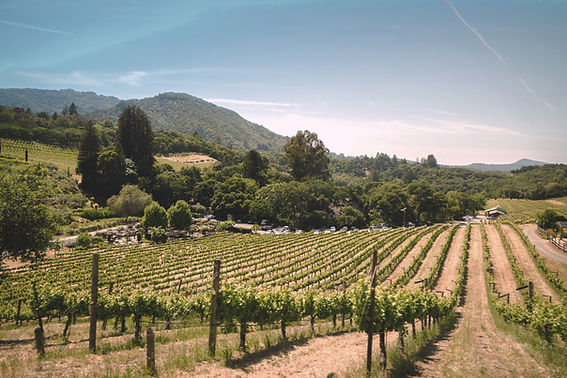What is Regenerative Viticulture?
- Victoria Daskal

- Oct 19, 2023
- 4 min read
Updated: Oct 31, 2023
Building on the principles of organic, biodynamic, and sustainable viticulture, regenerative viticulture focuses on rejuvenating soil health, promoting biodiversity, and mitigating the effects of climate change. It is based on the understanding that the health and fertility of soil is the foundation for life above and below ground and is the most important component of healthy terroir.
Regenerative viticulture offers a set of practices that can be adapted according to site, specific circumstances and vintage variation. This approach is seen as a mindset shift towards improving overall soil health and mitigating climate change which is why a regenerative vineyard plan could allow for carefully considered and targeted use of synthetic crop protection instead of a certified organic solution that involves numerous rounds by tractor through the vineyard spraying copper sulfate which over time leads to the build-up of heavy metal in soils, soil compaction, and excessive fuel consumption and pollution.
Key Principles of Regenerative Agriculture
· Strengthening the health and vitality of farm soil – By keeping the land covered with living vegetative cover, crop residues or mulch year-round. Using diverse and nitrogen-fixing cover crops that drawdown carbon, return nutrients to soil, control pests, prevent erosion, and decrease weeds. Tilling damages soil structure and results in the loss of soil organic material and should be avoided.
· Increasing biodiversity above and below ground – By planting flowering plants that create refuge zones for beneficial insects. Joining up wildlife corridors where there is extensive vineyard land, for example by planting hedges. Where possible introducing agroforestry, into the vineyard.
· Improving the water cycle - Reducing water usage by increasing water retention in the ground through variety of annual cover crops, planting appropriate grape varieties according to the climate on drought resistant rootstocks.
· Supporting carbon sequestration - The presence of roots in the soil not only helps with soil structure, but also supports mycorrhizal networks. Microbial life in the soil raises the organic matter present, which helps lock carbon in the soil, thus helping with the vineyard’s carbon footprint.
· Incorporate grazing animas – Livestock can help control weeds, provide natural fertilizing manure, while preserving soil structure. Overall, they play an important role in the regeneration of the soil they live on.
Advantages & Disadvantages of Regenerative Viticulture
Advantages
· A scientifically measurable method to improve soil health
· Increases overall biodiversity in and around the vineyard
· Minimising tillage improves soil structure, increases water retention, lowers soil temperatures and reduces topsoil erosion.
· An inclusive approach that takes into account different circumstances of the vineyards, and promotes better practices towards soil health rather than stringent rules that may not work universally
· Can take large amounts of CO2 out of the atmosphere and tie it back into the soil
· Protection of endemic wildlife, animal welfare, and social responsibility for farm labourers has positive impact on wider community
Disadvantages
· Different strands of regenerative philosophy (Regenerative Agriculture versus Regenerative Organic) with varying standards and practices
· Use of synthetic chemicals – even in special cases – considered by organic community as step backward in viticulture
· Rigorous certificate process though little to no awareness by end consumer
· Requires expertise and training to manage a more complex and interconnected system
Spotlight on Regenerative Wine Producers:
Domaine Gassier is a family owned and operated estate located in the Costières de Nîmes AOC of the Southern Rhone.
I met with 30-year old, Isabel Gassier, during my visit to Costières de Nîmes and was blown away by her passion and knowledge on the subject of regenerative viticulture. Below is a snippet of our conversation.
Q: What does Regenerative viticulture mean to you?
IG: The main idea of Regenerative agriculture is all about preserving biodiversity - and increasing biodiversity, sequestering carbon in your soil and restoring ecosystems (and their services).
It's all interconnected so you have to build a plan where you are always taking into account the balance between what a practice is going to do to my ecosystems and how does my crop fit into this.
Q: Why is it important to sequester carbon in your soil and how does it work?
IG: Sequestering carbon means taking carbon from the atmosphere and putting it into my soil. It helps mitigate climate change, and it raises the fertility of my soil, so it feeds my crop. It improves the ability of my soil to keep moisture so whenever it rains it avoids erosion and offers water to my plants throughout the year.
You do one thing for the ecosystem but in return it offers a great service to your crop.. That's what regenerative viticulture is all about.
Q: Is it necessary to be certified regenerative, in the way we see producers work towards being certified organic and biodynamic?
IG: For us it's important to get certification because it helps with having a farm plan when confronted with a problem. I can refer back to what were my commitments? How can we stick to the regenerative plan, stick to the values we set out? It's about being held accountable.

















Regenerative viticulture presents a compelling approach to vineyard management, focusing on soil health, biodiversity, and climate change mitigation. The principles outlined offer a holistic way to improve vineyard ecosystems. For students navigating the complexities of academic writing in related fields, a university assignment writing service can provide valuable support in articulating your understanding of such innovative practices.